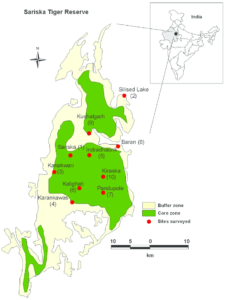Table of Contents
Sariska Tiger Reserve
The Sariska Tiger Reserve is a national park located in the Alwar district of Rajasthan, India. The park covers an area of 866 square kilometres and was declared a wildlife reserve in 1955.
In 1978, the park was declared a tiger reserve under the Project Tiger scheme to protect the endangered Bengal tiger. However, by 2004, all the tigers in the reserve had been poached, leading to a complete loss of the tiger population.
Efforts were then made to reintroduce tigers in the reserve, and in 2008, a relocation program was initiated, and tigers were brought from Ranthambore National Park to Sariska. The tiger population in the reserve has slowly increased since then, with several successful breeding programs.
Read about: Biosphere Reserves in India
Sariska Tiger Reserve Map
Here is a Map of Sariska Tiger Reserve given below:

Sariska Tiger Reserve Landscape
The landscape of Sariska Tiger Reserve is diverse and picturesque, featuring rugged terrain, steep slopes, and rocky plateaus. The reserve is situated in the Aravalli mountain range, which adds to its scenic beauty. The topography of the reserve is dominated by rocky hills, narrow valleys, and dense forests. The hills in the reserve are primarily composed of granite and quartzite, while the valleys are covered with alluvial soil.
The reserve is also home to several water bodies, including a few small lakes and a seasonal river called the “Siliserh River” that passes through the reserve. The rugged landscape of Sariska Tiger Reserve creates a unique ecosystem that supports a diverse range of flora and fauna. The stunning landscapes of the reserve offer a treat to the eyes of the visitors, making it a popular destination for nature lovers and adventure enthusiasts.
Read about: Tiger Reserves in India
Sariska Tiger Reserve Fauna
Below is an elaborate description of the fauna found in Sariska Tiger Reserve, which is known for its diverse range of wildlife species such as mammals, birds, reptiles, and other animals.
| Fauna | Description |
| Mammals | The reserve is well-known for its Bengal tiger population, which was reintroduced in 2008 after a complete loss of tiger population due to poaching. Other mammals found in the reserve include leopards, wild boars, sambar deer, spotted deer, nilgai, langurs, and hyenas. |
| Birds | The reserve is home to over 200 species of birds, including both resident and migratory birds. Some of the common bird species found in the reserve include peafowl, Indian eagle-owl, golden-backed woodpecker, and red-headed vulture. |
| Reptiles and Amphibians | The reserve has a variety of reptiles and amphibians, including snakes, lizards, and frogs. Some of the reptile species found in the reserve include Indian python, cobra, and monitor lizard. |
Read about: Nilgiri Biosphere Reserve
Sarika Tiger Reserve Flora
The following is an in-depth description of the flora present in Sariska Tiger Reserve, which is famous for its diverse plant species.
| Flora | Description |
| Types of Vegetation | The reserve has a variety of vegetation types, including tropical dry deciduous forests, tropical thorn forests, and tropical semi-evergreen forests. The vegetation is mainly composed of trees, shrubs, and grasses, with some patches of bamboo forests. |
| Dominant Tree Species | The dominant tree species in the reserve include Dhok (Anogeissus pendula), Khair (Acacia catechu), and Tendu (Diospyros melanoxylon). Other tree species found in the reserve include Sal (Shorea robusta), Semal (Bombax ceiba), Ber (Ziziphus mauritiana), and Bamboo (Dendrocalamus strictus). |
| Understory Vegetation | The understory vegetation in the reserve includes shrubs, herbs, and grasses such as Lantana (Lantana camara), Amla (Phyllanthus emblica), Ber (Ziziphus mauritiana), and Khus (Vetiveria zizanioides). The presence of invasive species like Lantana has been a concern for the reserve as it has the potential to overtake native vegetation. |
| Riparian Vegetation | The reserve has several streams and rivers running through it, which support a unique riparian vegetation. The riparian vegetation includes species such as Kadam (Neolamarckia cadamba), Siris (Albizia lebbeck), and Arjun (Terminalia arjuna) |
Read More: Pachmarhi Biosphere Reserve
Sariska Tiger Reserve Tourism
Tourism in Sariska Tiger Reserve is primarily centered around wildlife safaris, which offer visitors the opportunity to observe the wildlife in their natural habitat. The guided jeep safaris and canter safaris are conducted by the forest department and offer an unforgettable experience for visitors.
Sariska Tiger Reserve is also a great destination for birdwatchers, with over 200 species of birds found in the reserve. The reserve offers several birdwatching trails and birdwatching towers, allowing visitors to spot a wide range of bird species. Nature walks are another popular activity in Sariska Tiger Reserve, which allows visitors to explore the flora and fauna of the reserve. The reserve offers various nature trails and trekking routes, which offer an immersive experience of the natural beauty of the reserve.
Read More: Jim Corbett National Park
Sariska Tiger Reserve UPSC
In recent years, Sariska Tiger Reserve has gained significance in the context of the UPSC Syllabus, as questions related to the reserve have been asked in various papers, including the General Studies paper, the Environmental Studies paper, and the Geography paper. The reserve is often used as an example in questions related to wildlife conservation and biodiversity conservation, which is again an important part of the UPSC Syllabus. For gaining a better understanding of effective UPSC exam preparation, you can explore the official StudyIQ UPSC Online Coaching. Additionally, the website offers UPSC Mock Test for Prelims 2023, providing an opportunity to evaluate your level of preparation for the exam.


 Nilgiri Biosphere Reserve, Map, Climate,...
Nilgiri Biosphere Reserve, Map, Climate,...
 Repo Rate and Reverse Repo Rate, Impact ...
Repo Rate and Reverse Repo Rate, Impact ...
 Foreign Contribution Regulation Act (FCR...
Foreign Contribution Regulation Act (FCR...





















